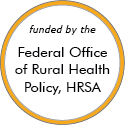Rural Mental Health – Models and Innovations
These stories feature model programs and successful rural projects that can serve as a source of ideas and provide lessons others have learned. Some of the projects or programs may no longer be active. Read about the criteria and evidence-base for programs included.
Evidence-Based Examples
Mental Health First Aid
Updated/reviewed August 2025
- Need: Rural areas face challenges in access to mental health services, including shortages of mental health providers.
- Intervention: This 8-hour course trains rural community members to recognize mental health and substance use issues and learn how to help someone who is developing a mental health concern or experiencing a mental health crisis.
- Results: Numerous studies of this method have found that course participants are better able and more likely to help others regarding mental health issues.
Effective Examples
I Got You: Healthy Life Choices for Teens (IGU)

Updated/reviewed February 2024
- Need: To improve awareness of behavioral and mental health issues by students in rural, east central Mississippi.
- Intervention: An intensive community mental health outreach program was implemented for students in rural Mississippi.
- Results: As of 2018 and on a yearly basis, 6,000 7th and 8th grade students receive mental health education on a variety of topics which improves their ability to recognize mental health issues, high risk behaviors, and manage their own choices.
University of Vermont Medical Center's Nursing Home Telepsychiatry Service
Updated/reviewed December 2023
- Need: To improve the health status and access for rural nursing home patients in need of mental health services.
- Intervention: The University of Vermont Medical Center provides telepsychiatry care and education to nursing homes in communities that face shortages of mental health professionals.
- Results: These telepsychiatry consultations have eased the burden on nursing home residents by saving travel time, distance, and money it takes to travel to the nearest tertiary facility.
Promising Examples
Schools That Care

Updated/reviewed September 2025
- Need: To provide mental health services to rural Kansas students and their families.
- Intervention: The Schools That Care project provides mental health treatment and case management as well as community education events.
- Results: From 2018 to 2021, 3,456 individuals participated in health education and counseling activities offered to the public, and 964 individuals and 303 families received direct services through the Family Advocate.
Cross-Walk: Integrating Behavioral Health and Primary Care

Updated/reviewed May 2024
- Need: To address and treat substance use disorder (SUD) and depression in the Upper Great Lakes region.
- Intervention: Cross-Walk, a program that integrates behavioral healthcare into primary care services, was developed in Michigan's Marquette County.
- Results: The collaborative efforts strengthened care management services in local healthcare facilities as primary care patients were referred to a behavioral health specialist.
Other Project Examples
Riverfront Talks: Substance Matters Podcast
Updated/reviewed December 2025
- Need: To reduce stigma around mental illness and substance use in North Carolina.
- Intervention: The Beaufort County Behavioral Health Task Force created the Riverfront Talks: Substance Matters podcast to interview people with lived experience.
- Results: As of December 2025, the podcast has 18 episodes.
Men's Conversation Group
Updated/reviewed November 2025
- Need: Suicide rates among men age 65 and older have been rising in North Carolina. Challenges include losing friends, illnesses, and the loss of independence – all of which can lead to isolation and depression.
- Intervention: Chatham County Aging Services of North Carolina started the Men's Conversation Group to connect retired men in need of male friends and mutual support.
- Results: Men in similar stages of life and varying backgrounds are forming friendships, engaging in activities, and taking care of their mental health.
FirstLink Care and Support Program
Updated/reviewed July 2025
- Need: To reduce suicide and substance-related deaths in North Dakota and Minnesota.
- Intervention: The Care and Support program provides support through phone calls, cards, and texting to those who have called suicide helplines or were referred by a healthcare provider.
- Results: In 2024, FirstLink sent 2,870 cards and texts to program participants and made 12,378 total contacts.
Together With Veterans Rural Suicide Prevention Program
Updated/reviewed July 2025
- Need: Suicide among veterans has been steadily increasing, and rural veterans have an increased risk of death by suicide compared to urban veterans.
- Intervention: A program called Together with Veterans was formed to help rural communities address and prevent suicides among veterans. The initiative is veteran-led, collaborative, evidence-based, and community-centered.
- Results: Data collection is ongoing.
Hope Squad
Updated/reviewed June 2025
- Need: To reduce youth suicide rates.
- Intervention: First begun in Utah, Hope Squad is a nationwide program that trains youth to identify peers' signs of distress and connect them to help. Hope Squads educate the entire student body to increase connectedness and reduce stigma.
- Results: Studies suggest that Hope Squad schools' students with suicidal thoughts are more likely than non-Hope Squad schools' students to solicit help. In addition, stigma surrounding mental illness is decreasing.
Last Reviewed: 6/7/2024

